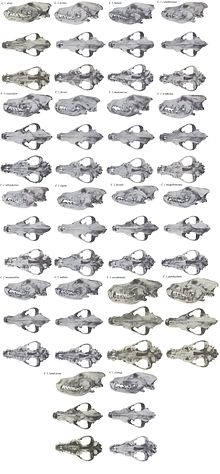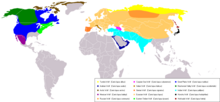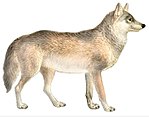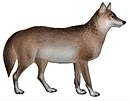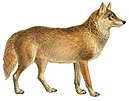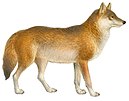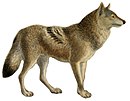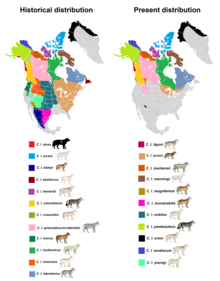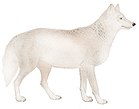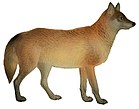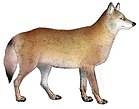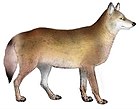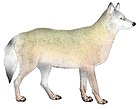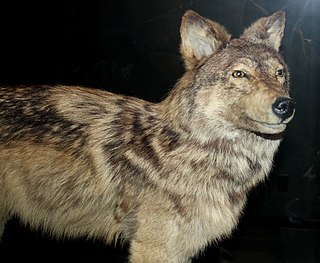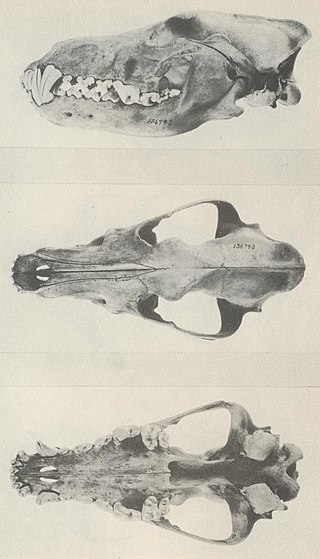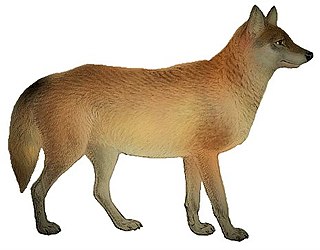| Subspecies | Image | Authority | Description | Range | Taxonomic synonyms |
|---|
|
C. l. arctos
Arctic wolf | 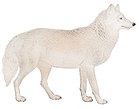 | Pocock, 1935 [47] | A medium-sized, almost completely white subspecies. [48] | Melville Island (the Northwest Territories and Nunavut), Ellesmere Island | The current (2022) classification of the more broadly defined C. l. arctos of Nowak (1995) synonymizes C. l. orion and C. l. bernardi. [1] [49] |
|---|
C. l. baileyi
Mexican wolf | 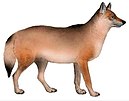 | Nelson and Goldman, 1929 [50] | The smallest of the North American subspecies, with dark fur. [51] | found in southwestern New Mexico and southeastern Arizona as well as northern Mexico; once ranged into western Texas | |
|---|
C. l. columbianus
British Columbian wolf |  | Goldman, 1941 | Smaller-sized; unique diet of fish and smaller-sized deer in temperate rainforest; similar to crassodon. | Coastal British Columbia and the coastal Yukon | Currently (2023) synonymized under C. l. crassodon. |
|---|
C. l. crassodon
Vancouver Island wolf | 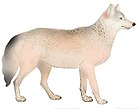 | Hall, 1932 | A medium-sized subspecies with grayish fur; similar to columbianus. [52] | Vancouver Island, British Columbia | Currently (2023) C. l. crassodon synonymizes C. l. ligoni and C. l. columbianus. |
|---|
C. l. familiaris
Domestic dog
but refer Synonyms |  | | | worldwide | The domestic dog is a divergent subspecies of the gray wolf and was derived from an extinct population of Late Pleistocene wolves. [8] [31] [32] Through selective pressure and selective breeding, the domestic dog has developed into hundreds of varied breeds and shows more behavioral and morphological variation than any other land mammal. [33]
aegyptius Linnaeus, 1758, alco C. E. H. Smith, 1839, americanus Gmelin, 1792, anglicus Gmelin, 1792, antarcticus Gmelin, 1792, aprinus Gmelin, 1792, aquaticus Linnaeus, 1758, aquatilis Gmelin, 1792, avicularis Gmelin, 1792, borealis C. E. H. Smith, 1839, brevipilis Gmelin, 1792, cursorius Gmelin, 1792, domesticus Linnaeus, 1758, extrarius Gmelin, 1792, ferus C. E. H. Smith, 1839, fricator Gmelin, 1792, fricatrix Linnaeus, 1758, fuillus Gmelin, 1792, gallicus Gmelin, 1792, glaucus C. E. H. Smith, 1839, graius Linnaeus, 1758, grajus Gmelin, 1792, hagenbecki Krumbiegel, 1950, haitensis C. E. H. Smith, 1839, hibernicus Gmelin, 1792, hirsutus Gmelin, 1792, hybridus Gmelin, 1792, islandicus Gmelin, 1792, italicus Gmelin, 1792, laniarius Gmelin, 1792, leoninus Gmelin, 1792, leporarius C. E. H. Smith, 1839, major Gmelin, 1792, mastinus Linnaeus, 1758, melitacus Gmelin, 1792, melitaeus Linnaeus, 1758, minor Gmelin, 1792, molossus Gmelin, 1792, mustelinus Linnaeus, 1758, obesus Gmelin, 1792, orientalis Gmelin, 1792, pacificus C. E. H. Smith, 1839, plancus Gmelin, 1792, pomeranus Gmelin, 1792, sagaces C. E. H. Smith, 1839, sanguinarius C. E. H. Smith, 1839, sagax Linnaeus, 1758, scoticus Gmelin, 1792, sibiricus Gmelin, 1792, suillus C. E. H. Smith, 1839, terraenovae C. E. H. Smith, 1839, terrarius C. E. H. Smith, 1839, turcicus Gmelin, 1792, urcani C. E. H. Smith, 1839, variegatus Gmelin, 1792, venaticus Gmelin, 1792, vertegus Gmelin, 1792 [53] Increasingly proposed as the species Canis familiaris but debated [54] [30] |
|---|
C. l. hudsonicus
Hudson Bay wolf |  | Goldman, 1941 | A light-colored subspecies similar to occidentalis, but smaller. [55] | Northern Manitoba and the Northwest Territories | Currently (2022) synonymized under C. l. nubilus [1] [56] |
|---|
C. l. irremotus
Northern Rocky Mountain wolf | 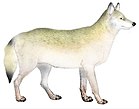 | Goldman, 1937 [57] [58] | A medium-sized to large subspecies with pale fur. [59] | The northern Rocky Mountains | Currently (2022) synonymized under C. l. occidentalis [1] [60] |
|---|
C. l. labradorius
Labrador wolf |  | Goldman, 1937 [57] | A medium-sized, light-colored subspecies. [61] | Labrador and northern Quebec; recent confirmed sightings on Newfoundland [62] [63] | Currently (2022) synonymized under C. l. nubilus [1] [64] |
|---|
C. l. ligoni
Alexander Archipelago wolf | 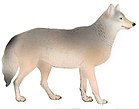 | Goldman, 1937 [57] | A medium-sized, dark-colored subspecies. [65] | The Alexander Archipelago, Alaska | Currently (2023) synonymized under C. l. crassodon. |
|---|
C. l. lycaon
Eastern wolf
but refer Synonyms |  | Schreber, 1775 | Two forms are known – a small, reddish-brown colored form called the Algonquin wolf; and a slightly larger, more grayish-brown form called the Great Lakes wolf, which is an admixture of the Algonquin wolf and other gray wolves. [66] | The Algonquin form occupies central Ontario and southwestern Quebec, particularly in and nearby protected areas, such as Algonquin Provincial Park in Ontario, and possibly extreme northeastern U.S. and western New Brunswick. The Great Lakes form occupies northern Ontario, Wisconsin and Minnesota, the Upper Peninsula of Michigan and southern Manitoba. Overlaps of the two forms occur, with intermixing in the southern portions of northern Ontario. | canadensis de Blainville, 1843, ungavensis Comeau, 1940 [67]
The Algonquin form is currently (2022) recognized as the species Canis lycaon [68] by the American Society of Mammologists, but its taxonomy is still debated. [69] |
|---|
C. l. mackenzii
Mackenzie River wolf |  | Anderson, 1943 | A subspecies with variable fur and intermediate in size between occidentalis and manningi. [70] | The southern Northwest Territories | Currently (2022) synonymized under C. l. occidentalis [1] [71] |
|---|
C. l. manningi
Baffin Island wolf |  | Anderson, 1943 | The smallest subspecies of the Arctic, with buffy-white fur. [72] | Baffin Island | Currently (2022) synonymized under C. l. nubilus [1] [73] |
|---|
C. l. occidentalis
Northwestern wolf |  | Richardson, 1829 | A very large, usually light-colored subspecies, and the biggest subspecies. [74] | Alaska, the Yukon, the Northwest Territories, British Columbia, Alberta, Saskatchewan, and the northwestern United States | ater Richardson, 1829, sticte Richardson, 1829 [75] The C. l. occidentalis of Nowak (1995) synonymizes alces, columbianus, griseoalbus, mackenzii, pambasileus and tundrarum, which is the currently (2022) recognized classification. [1] |
|---|
C. l. orion
Greenland wolf |  | Pocock, 1935 | | Greenland and the Queen Elizabeth Islands [76] | Currently (2022) synonymized under C. l. arctos [1] [77] |
|---|
C. l. pambasileus
Alaskan Interior wolf |  | Miller, 1912 | The second largest subspecies of wolf, second in skull and tooth proportions only to occidentalis (see chart above), with fur that is black, white or a mixture of both in color. [78] | The Alaskan Interior and the Yukon, save for the tundra region of the Arctic Coast [79] | Currently (2022) synonymized under C. l. occidentalis [1] [80] |
|---|
C. l. nubilus
Great Plains wolf | 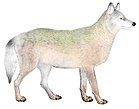 | Say, 1823 | A medium-sized, light-colored subspecies. [81] | Throughout the Great Plains from southern Manitoba and Saskatchewan southward to northern Texas [82] | variabilis Wied-Neuwied, 1841. [83] Previously thought extinct in 1926, the Great Plains wolf's descendants were found in the northeastern region of the United States and have become federally protected since 1974. [84] As of 2022 the classification of the more broadly defined C. l. nubilus of Nowak (1995) synonymizes beothucus, fuscus, hudsonicus, irremotus, labridorius, manningi, mogollonensis, monstrabilis and youngi, in which case the subspecies is extant in Canada (see infobox map). [1] |
|---|
C. l. rufus
Red wolf
but refer Synonyms |  | Audubon and Bachman, 1851 | Has a brownish or cinnamon pelt, with gray and black shading on the back and tail. Generally intermediate in size between other North American wolf subspecies and the coyote. Like other wolves, it has almond-shaped eyes, a broad muzzle and a wide nose pad though, like the coyote, its ears are proportionately larger. It has a deeper profile, a longer and broader head than the coyote, and has a less prominent ruff than other wolves. [85] | Historically distributed throughout the Eastern, Southern, and Midwestern United States, from southernmost New York south to Florida and west to Texas. Modern range is eastern North Carolina. [86] | Currently considered a distinct species, Canis rufus, but this proposal is still debated. [2] As a species, the red wolf would have the following subspecies: - Canis rufus rufus , formerly Canis niger rufus (Texas red wolf)
- Canis rufus floridanus , formerly Canis niger niger (Florida black wolf)
- Canis rufus gregoryi , formerly Canis niger gregoryi (Mississippi Valley red wolf)
|
|---|
C. l. tundrarum
Alaskan tundra wolf | 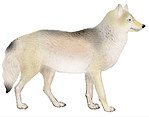 | Miller, 1912 | A large, white-colored subspecies closely resembling pambasileus, though lighter in color. [87] | The Barren Grounds of the Arctic Coast region from near Point Barrow eastward toward Hudson Bay and probably northwards to the Arctic Archipelago [88] | Currently (2022) synonymized under C. l. occidentalis [1] [89] |
|---|
